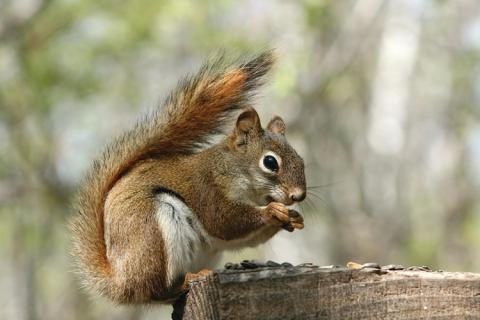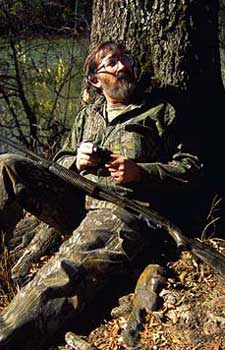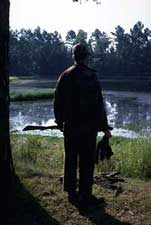
Many thousands of words have been written about basic squirrel hunting techniques, and it's not my intention to rehash this information in great detail. My goals are, first, to share some basic knowledge that personally has proven successful, and second, to discuss some of the less commonly encountered facts about squirrel behavior, facts the savvy sportsmen can use to improve the odds for a successful hunt.
 TIP: Shop Hunting Gear at Bass Pro Shops
TIP: Shop Hunting Gear at Bass Pro Shops
Types of Squirrel Species to Hunt
Fox squirrels and gray squirrels are the two species that absorb most of the hunting pressure. The fox squirrel is found throughout much of the eastern two-thirds of the country, though there are large swaths of territory in this range, most notably in the Northeast, they don't inhabit. Grays range from the Atlantic Ocean to Texas and North Dakota, and along the West Coast and part of Arizona.
Grays are agile, streamlined squirrels weighing 3/4 to 1 1/2 pounds. Fox squirrels are chunky and squat, slower moving, and usually much larger, weighing up to 3 pounds. Both species may occupy the same areas, but fox squirrels are typically found in more open woods, usually near the forest edge. Grays prefer dense stands of trees in deeper woods.
The species also differ in activity periods. Grays are most active at first light; fox squirrels arise a bit later. Hunters should be in gray squirrel woods at dawn and hunt the first two hours for best results. The third  hour is somewhat productive, but midday usually offers poor hunting. A little activity can be expected most of the afternoon, but there's no worthwhile peak.
hour is somewhat productive, but midday usually offers poor hunting. A little activity can be expected most of the afternoon, but there's no worthwhile peak.
When hunting strictly for fox squirrels, you can stay in bed an hour later and find best results the second and third hour after sunrise. The first hour is OK, but again, afternoon activity is minimal. Top hunting in woods harboring both fox and gray squirrels is during the first three hours of daylight.
TIP: How to Skin Squirrels: Step by Step Picture Guide
Likely Squirrel Hunting Areas
You can check with the local wildlife conservation officer or your state wildlife agency for tips on likely squirrel hunting areas, but it's also easy to discover locations on your own. Just look for woods with mature nut-bearing trees open to hunting, and you should find squirrels. The setup is even better if there's a stream flowing through the area, or maybe a nearby farm pond or cornfield.
 Acorns are the most abundant and basic food of squirrels, but you can't take it for granted that acorns will be abundant every fall. There are two primary groups of oaks: white and red. Except in poor growing years, white oaks produce mast every year. Red oak acorns require two years to mature, thus their crops are staggered.
Acorns are the most abundant and basic food of squirrels, but you can't take it for granted that acorns will be abundant every fall. There are two primary groups of oaks: white and red. Except in poor growing years, white oaks produce mast every year. Red oak acorns require two years to mature, thus their crops are staggered.
Further, white oak acorns are preferred by all wildlife, because they're sweet. Red oak acorns are bitter, and though squirrels eat them, if they have a choice they may be found in greater numbers in white oak stands. Some trees may also get special attention because they produce larger acorns or because their acorns are exceptionally abundant.
What's all this mean?
Simply this: Don't be mislead into thinking squirrels will be found in every patch of oaks. The astute squirrel hunter doesn't just hunt squirrels in oaks; he looks for them in or near particular oak varieties, even narrowing it down to specific trees. Check for acorns and fresh cuttings (fragments of nutshells) on the ground. Fresh cuttings have brightly colored edges, a sign squirrels have been feeding in the area, and it should be good for hunting.
Walnuts, beechnuts, hickory nuts, pecans, butternuts and other hard mast are all eagerly sought. Crafty squirrel hunters also keep a lookout for special forage items other hunters may overlook. Fox squirrels love corn at all stages of its development, thus woods near a cornfield are certain to be a good place to take a stand.
Osage oranges, fruit of the bois d'arc tree, are another relished specialty, and during both winter and spring, squirrels may be found gorging on the buds and flowers of maples, birch, basswood, elms and other trees. Seasonal fruits like wild cherries, wild grapes, hackberries, mulberries and persimmons are especially important to the hunter, because they often concentrate squirrels in small areas, if only for brief periods. The hunter who knows what's top choice on the squirrel menu in his area is most likely to enjoy squirrel stew.
How Weather Affects Squirrel Hunting
 Weather is an important consideration for the squirrel hunter, because weather dictates specific squirrel behavior and hunting methods.
Weather is an important consideration for the squirrel hunter, because weather dictates specific squirrel behavior and hunting methods.
Squirrels, like people, enjoy pleasant weather, and still, sunny mornings and afternoons will find them actively feeding. If the woods are dry on these days, hunters should listen as much as they look, as squirrels will often be heard before they're seen. When woods are dry, it's also wise to sit while hunting, rather than prowling noisily about.
Wet woods and mist or drizzle change the picture. If the temperature is mild, squirrel hunting can be superb. Bushytails don't mind wet days and are often seen foraging on the ground with tail spread over back and head like an umbrella. The damp forest floor creates ideal conditions for the quiet stalker.
Approaching fronts, persistent stormy weather and high wind shut off squirrel activity like closing a water tap. Squirrels den up and stay until the weather changes, drastically reducing your chances for success. Hunting in leafless, snowy woods in the dead of winter is also difficult. Squirrels don't hibernate, but they may remain inactive in their dens for days on end.
You needn't forgo the pleasures of squirrel hunting just because the weather isn't perfect. But knowing how your quarry will react to various weather conditions can help you make the best of your time afield.
TIP: Hunting Squirrels During Winter
8 More Squirrel Hunting Tips
 1. Clothing with bark-pattern camouflage like TrueTimber camo hunting clothing will do wonders to conceal you from wary squirrels, but safety aspects should also be considered. When you're leaning against a tree, another hunter could mistake any slight movement for a squirrel. It happens with tragic regularity, and in many states, "victim mistaken for squirrel" is one of the leading causes of hunting accidents. Be cautious, and wear fluorescent orange clothing whenever appropriate.
1. Clothing with bark-pattern camouflage like TrueTimber camo hunting clothing will do wonders to conceal you from wary squirrels, but safety aspects should also be considered. When you're leaning against a tree, another hunter could mistake any slight movement for a squirrel. It happens with tragic regularity, and in many states, "victim mistaken for squirrel" is one of the leading causes of hunting accidents. Be cautious, and wear fluorescent orange clothing whenever appropriate.
Tip: Shop Ladies' TrueTimber Hunting Clothing here
Tip: Shop Kids' TrueTimber Hunting Clothing here

2. Choosing between a rifle and shotgun is a trade-off. The rifle gives you a better range, but the shotgun offers an advantage on running squirrels — and you're almost sure to be taking shots at running squirrels when stalking. The rifle, on the other hand, gives you more opportunities to get off long-range shots before your presence is detected in leaf-bare woods.
TIP: The Ruger 10/22 Rimfire rifle is one of the most popular, and widely used rimfire rifles in the US. And justifiably so—the 10/22 has had a solid reputation for reliability and accuracy for over 50 years, making it a favorite for target shooting, plinking, and small game hunting.
It's best to use a firearm you're most comfortable shooting. Whether you shoot a rifle or a shotgun, you'll win some and lose some. That's the joy of hunting, regardless of the quarry.

TIP: The Remington Model 870 Pump-Action Shotgun is one of the most proven firearm's designs in history. It's an extremely useful firearm for young people looking for their first gun, or experienced shooters of smaller stature.
3. Keep in mind that stalking is much easier during the early part of the season. Squirrels are less wary then, and there are plenty of young, foolish ones around. Leafy branches restrict the squirrel's vision. And most nuts are still clinging to the branches, so squirrels will be in the trees where they're easier to spot.
4. Never stalk with the sun off either shoulder. Doing so makes your shadow sweep across the ground perpendicular to your movements, increasing your chances of being seen. When leaves are still on, stalk into the sun if possible. It's easier to spot moving squirrels in leafy branches if they're outlined against the sun. Later in the season, when squirrels forage more on the ground, it may be best to hunt with the sun at your back to put the glare in your quarry's eyes. Either way, use a tree shadow to hide your own when stalking in for the kill.
5. During mast-poor years in hilly terrain, center your search for squirrels on north-facing slopes. The north slopes are more protected from sunlight and tend to retain moisture better. Consequently, they usually have more hardwoods, better mast crops and more squirrels.
 6. If you locate several squirrels feeding in a small area, mark the location of the first kill, satisfy yourself it's dead, then stay put. Within five to 10 minutes, the remaining squirrels are likely to be moving again, and you'll get another shot.
6. If you locate several squirrels feeding in a small area, mark the location of the first kill, satisfy yourself it's dead, then stay put. Within five to 10 minutes, the remaining squirrels are likely to be moving again, and you'll get another shot.
7. If possible, hunt mountains or hilly areas when wind conditions are unfavorable. Scouting will often reveal a few hollows where calmer conditions prevail and squirrels are more active.
8. Keep your ears tuned. Rustling leaves can give a squirrel away. So can the sound of the rodent's sharp teeth gnawing a nut, or cuttings falling to the forest floor. Also listen for barking or chattering squirrels.
If you're a squirrel-hunting fan, be sure to bone up on bushytail basics before your next hunt. No matter what the weather or time of day, no matter if you hunt by stalking or from a stand, no matter if you hunt alone or with partner, there are always squirrels to be found. But whether or not you find them depends on how well you play the game.
- 75922 views

